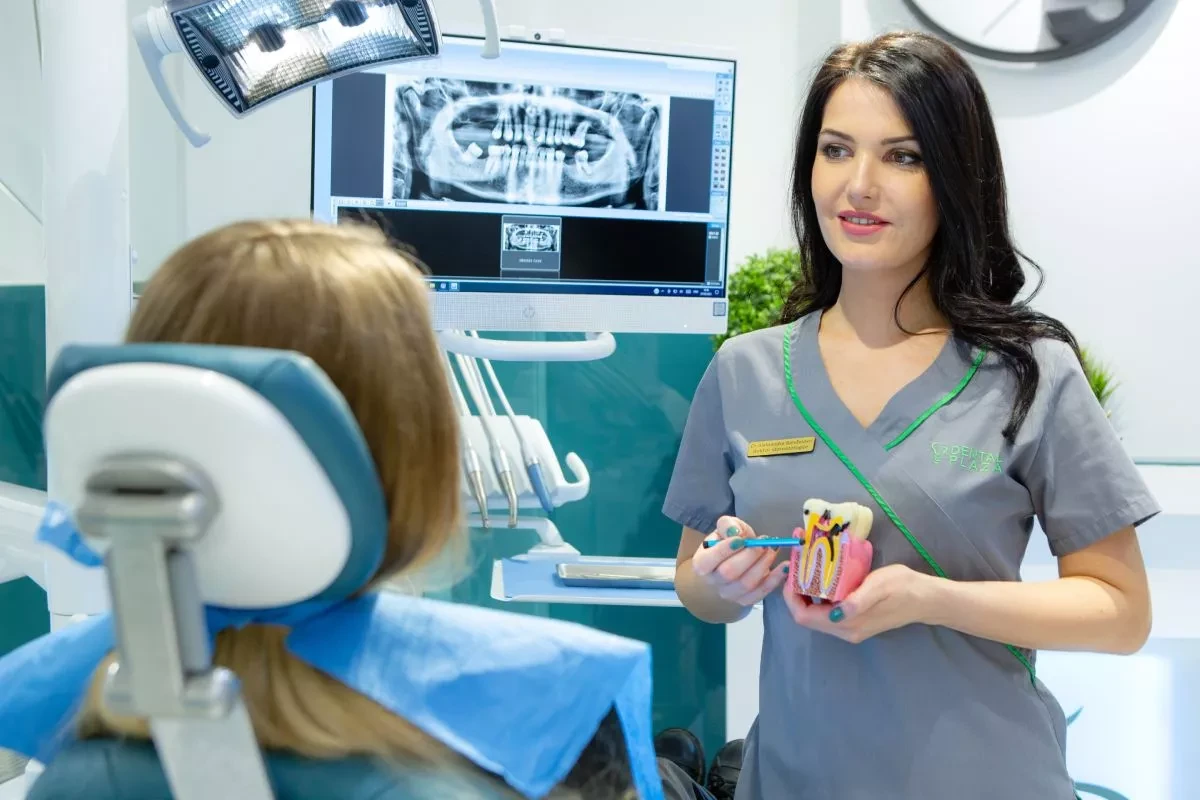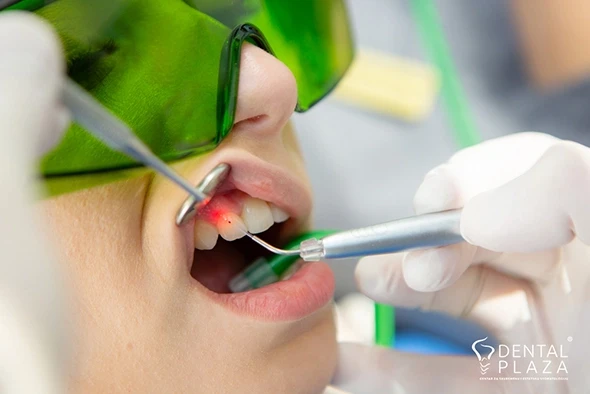Do not be shy, show your teeth!
Call Center 08-21h
Do not be shy, show your teeth!
Call Center 08-21h

Periodontopathy is a progressive, degenerative disease of the periodontium (the supporting apparatus of the tooth) which, as a function of time, can lead to clenching, shifting and loss of tooth. In addition to caries, it is the most common disease of the dento-facial region.
When it comes to periodontopathy, the most common causes are dental plaque microorganisms. Dental plaque is an organic, bacterial, colorless soft deposit that accumulates on the teeth. Improper maintenance of oral hygiene favors the accumulation of dental plaque and accelerates the process of deterioration of the supporting apparatus of the teeth.
If the disease is in the initial stages and the symptoms are mild, the causal phase of therapy is applied, which involves cleaning soft and hard deposits, as well as treatment of periodontal pockets. All periodontal patients go through this phase of therapy, regardless of the type and severity of the disease. If the disease progresses and there are deep periodontal pockets, surgical therapy is applied. This phase involves the identification of dental plaque first.
During a dental examination, dental plaque is identified with a dental probe. Special solutions and tablets can also be used to identify dental plaque, which will discolor the surfaces of the teeth where dental plaque is located. In this way, we draw the patient's attention to the presence of dental plaque, which is the most important factor in the development of periodontal disease. This is followed by education and motivation of the patient to maintain proper oral hygiene. The patient receives explanations of how often, in what way and with what technique oral hygiene is maintained.
.webp)
Next, the removal of tartar and subgingival concrements follows. Tartar is formed by the mineralization of dental plaque. Tartar is formed exclusively in conditions of inadequate oral hygiene. Its uneven surface is an ideal substrate for the formation and accumulation of new amounts of dental plaque. Dental calculus also makes it difficult or even completely impossible to maintain oral hygiene. Therefore, regular visits to the dentist, regular removal of dental calculus and of concrements, as well as maintaining good results after the end of this phase of therapy are very important.
A more severe clinical picture of periodontopathy is accompanied by the appearance of deep periodontal pockets and by exposure of the tooth necks due to receding gingiva. In such situations, periodontal-surgical methods of treatment are indicated, which have shown very good results in preventing further deterioration of the supporting apparatus of the teeth.
Periodontal surgery involves a large number of interventions. The most commonly applied are the so-called lobe surgery, which cleans periodontal pockets under direct eye control. If the periodontal pockets are deep and there is significant bone resorption - a lobe or ''flap'' operation is suggested, with the addition of artificial bone and resorptive membranes. In this way, all pathological granulations, ie. harmful substances accumulated in the pocket, are eliminated, and the lost part of the bone is replaced with artificial bone. In this way, the life of periodontal teeth is extended and the further development of periodontal disease is prevented.
Also, this broad area of dentistry also covers interventions that correct soft tissues (gingivectomy, gingivoplasty).
As part of periodontal surgery, clinical dental crown lengthening interventions are also performed. These interventions are applied when the proportion of the width and length of the crown of the tooth is disturbed, which is aesthetically unacceptable. The goal of lengthening the clinical dental crown is to achieve the necessary and harmonious smile through the correct length and proportion of the teeth.
Treatment of exposed root (recession) of the teeth is also an area covered by periodontal surgery. In these cases, connective tissue grafts (TVT) or SMAT can be used to cover the exposed part.

In children, frenectomy is most often used intervention, that is, the removal of the fold that connects the upper or lower lip to the gums, as well as the fold that connects the tongue to the floor of the oral cavity. There are two methods for frenulum removal ie. frenectomies: surgical method and laser frenectomies.
All these interventions are performed under local anesthesia, are painless and completely comfortable for the patient. After periodontal surgery, discomfort should be minimal. Postoperative pain and swelling are insignificant for a few days after the intervention. With the dentist's instructions, you can take painkillers and possibly antibiotics during that period if necessary. Slight swelling may occur, in which case we recommend using cold compresses. In the period from 5 to 7 days, you should eat as soft food as possible, and in that period you should avoid hard physical activity. The Dental Plaza team is always at your disposal for any questions.

Do you have questions?

Periodontopathy is a progressive, degenerative disease of the periodontium (the supporting apparatus of the tooth) which, as a function of time, can lead to clenching, shifting and loss of tooth. In addition to caries, it is the most common disease of the dento-facial region.
When it comes to periodontopathy, the most common causes are dental plaque microorganisms. Dental plaque is an organic, bacterial, colorless soft deposit that accumulates on the teeth. Improper maintenance of oral hygiene favors the accumulation of dental plaque and accelerates the process of deterioration of the supporting apparatus of the teeth.
If the disease is in the initial stages and the symptoms are mild, the causal phase of therapy is applied, which involves cleaning soft and hard deposits, as well as treatment of periodontal pockets. All periodontal patients go through this phase of therapy, regardless of the type and severity of the disease. If the disease progresses and there are deep periodontal pockets, surgical therapy is applied. This phase involves the identification of dental plaque first.
During a dental examination, dental plaque is identified with a dental probe. Special solutions and tablets can also be used to identify dental plaque, which will discolor the surfaces of the teeth where dental plaque is located. In this way, we draw the patient's attention to the presence of dental plaque, which is the most important factor in the development of periodontal disease. This is followed by education and motivation of the patient to maintain proper oral hygiene. The patient receives explanations of how often, in what way and with what technique oral hygiene is maintained.
.webp)
Next, the removal of tartar and subgingival concrements follows. Tartar is formed by the mineralization of dental plaque. Tartar is formed exclusively in conditions of inadequate oral hygiene. Its uneven surface is an ideal substrate for the formation and accumulation of new amounts of dental plaque. Dental calculus also makes it difficult or even completely impossible to maintain oral hygiene. Therefore, regular visits to the dentist, regular removal of dental calculus and of concrements, as well as maintaining good results after the end of this phase of therapy are very important.
A more severe clinical picture of periodontopathy is accompanied by the appearance of deep periodontal pockets and by exposure of the tooth necks due to receding gingiva. In such situations, periodontal-surgical methods of treatment are indicated, which have shown very good results in preventing further deterioration of the supporting apparatus of the teeth.
Periodontal surgery involves a large number of interventions. The most commonly applied are the so-called lobe surgery, which cleans periodontal pockets under direct eye control. If the periodontal pockets are deep and there is significant bone resorption - a lobe or ''flap'' operation is suggested, with the addition of artificial bone and resorptive membranes. In this way, all pathological granulations, ie. harmful substances accumulated in the pocket, are eliminated, and the lost part of the bone is replaced with artificial bone. In this way, the life of periodontal teeth is extended and the further development of periodontal disease is prevented.
Also, this broad area of dentistry also covers interventions that correct soft tissues (gingivectomy, gingivoplasty).
As part of periodontal surgery, clinical dental crown lengthening interventions are also performed. These interventions are applied when the proportion of the width and length of the crown of the tooth is disturbed, which is aesthetically unacceptable. The goal of lengthening the clinical dental crown is to achieve the necessary and harmonious smile through the correct length and proportion of the teeth.
Treatment of exposed root (recession) of the teeth is also an area covered by periodontal surgery. In these cases, connective tissue grafts (TVT) or SMAT can be used to cover the exposed part.

In children, frenectomy is most often used intervention, that is, the removal of the fold that connects the upper or lower lip to the gums, as well as the fold that connects the tongue to the floor of the oral cavity. There are two methods for frenulum removal ie. frenectomies: surgical method and laser frenectomies.
All these interventions are performed under local anesthesia, are painless and completely comfortable for the patient. After periodontal surgery, discomfort should be minimal. Postoperative pain and swelling are insignificant for a few days after the intervention. With the dentist's instructions, you can take painkillers and possibly antibiotics during that period if necessary. Slight swelling may occur, in which case we recommend using cold compresses. In the period from 5 to 7 days, you should eat as soft food as possible, and in that period you should avoid hard physical activity. The Dental Plaza team is always at your disposal for any questions.
